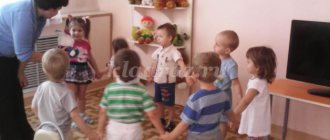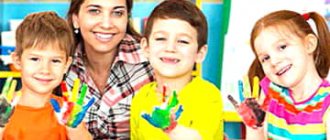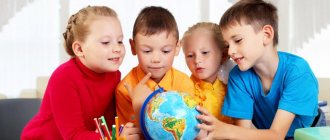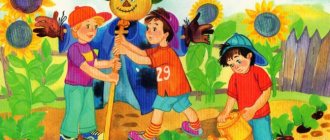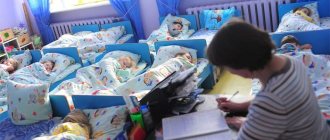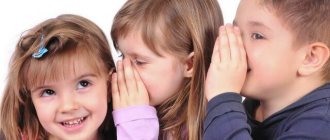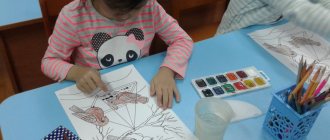Quest game “In search of emotions”
Quest game scenario for children 4-5 years old
"In Search of Emotions"
Target:
improving ideas about various emotional states in children 4-5 years old.
Tasks:
systematize children’s ideas about basic emotions (joy, sadness, surprise, anger, fear);
develop cognitive interest in your emotions and the emotions of other people;
improve communication skills;
cultivate a friendly attitude towards each other, a desire to help.
Equipment:
laptop, presentation “In Search of Emotions”, envelopes with tasks, map, chest with a lock, flowers with emotions, easel, picture of a cloud, cards with faces-emotions according to the number of children.
Progress of the quest game.
The psychologist calls the children to him.
- You guys, don’t be lazy, gather in a circle quickly, one, two, three, four, five, I invite you to play.
Children gather in a circle next to the educational psychologist. Slide 1.
The sound of the intro of the cartoon "Paw Patrol" is heard
— Guys, do you recognize this song? (children's answers) Slide 2.
On the screen is one of the Paw Patrol heroes:
-Hello guys, Ryder is in trouble! Team Catstrophe stole and hid Ryder's emotions. He stopped experiencing emotions - joy, surprise, sadness and even anger and fear. Please help us find and return Ryder's emotions!
- What can we do? (children's answers)
Slide 3.
On the screen is the Paw Patrol team:
“We got hold of a map where Kotostroph’s team hid their emotions.” Use it, it will help you. Slide 4.
- What is this? (children's answers)
— I suggest looking at the map. Multi-colored arrows indicate the route along which we will move in search of emotions.
1. Green path
They approach a table with a green sign on which lies an envelope with a riddle.
Task: solve the riddle.
The person experiencing the emotion we are looking for can be recognized by their expression: the corners of the mouth are lowered down, the eyes are closed, tears may even come from the eyes. This feeling happens when we are lonely, have no one to play with, or something is not working out. Children guess the riddle (Slide 5)
and receive the first flower with the emotion of sadness.
2. Red path
Slide 6
. Cheerful music is turned on.
— What kind of music does it sound like? (children's answers)
- When do we feel happy and happy? (children's answers)
— We have come to the next sign.
There is an envelope with the task on the table - it contains a cut-out picture depicting an emotion. Collect it and find out what emotion you will receive as a gift.
Children assemble a picture to the sound of cheerful music. Receive a second flower depicting the emotion of joy
.
Slide 7.
3. Blue path
. (Disturbing music sounds)
— What is the nature of the music? (children's answers)
- So what kind of emotion
? (children's answers)
- When do we get scared? (children's answers)
There is an envelope with a task on the table with a blue pointer - share your emotions
into positive and negative.
- You did everything right! – you receive a flower with the emotion of fear
.
4. Yellow path
Slide 8.
(music plays in the background).
— Guys, we have a chest here with a lock with a combination lock, to open it you need to know a 4-digit code, and to do this you need to complete the following tasks:
1. Portray joy - please smile like a cat in the sun Slide 9
4
appears on the screen (
Slide 10)
) The children dial the number 4 on the lock.
2. Show how angry the child was when his toy was taken away Slide 11
;
3 appears (Slide 12)
. Children dial it on lock
3. Show how scared the hare was when he saw the wolf Slide 13
.
4
appears (Slide 14).
Children dial on the castle
4. What emotion is depicted on Slide 15
(children’s answers) After the children’s answers, the number
0 Slide 16.
- Well done, guys, we solved the code and opened the lock.
- What's in the chest? (children's answers)
— There are two flowers with emotions here!
- What emotions are these? (children's answers)
— To send emotions to Ryder, you need to put the collected flowers in a magic chest and the boy will definitely receive them. Slide 17
.
Rider appears on the screen:
- Well done, guys, you collected all the emotions, now I can again be happy, surprised, sad and even angry and afraid. Thank you! See you again!
— Guys, our adventure “In Search of Emotions”
».
- Do you think you succeeded? (children's answers)
- I suggest you determine your mood. Take a card with a picture of your mood and attach it to the cloud.
Analysis of selected cards. Guys, I had an interesting time with you today, you’re so easy! Thanks everyone!
Summary of the lesson of a teacher-psychologist in the junior group “A bird flew in and sat in our arms!”
Summary of an integrated lesson in the junior group “A bird flew in and sat in our arms!”
Goal: teaching skills to interact with peers through game exercises.
Objectives: -development of mental processes: memory, attention, development of thinking; — development of communication skills — development of fine motor skills.
Stimulus material: chairs according to the number of children, a “Bird” toy, a ball, pictures with animals 5-7 pcs.
Progress.
Acquaintance. Exercise "Bird". Teacher-psychologist: “Good afternoon guys! I'm glad to see you here. I have a wonderful bird sitting in my arms, open your palms, she will sit on them. Whoever she sits with must say his name and say what his mood is today: happy, sad, sad, cheerful, etc.”
Exercise “Give the mood.” Educational psychologist: “Guys, if one of your friends is in a sad mood, of course we need to console such a friend. Let’s figure out what words to say to a friend so that his mood improves.” The children come up with comforting words, and the educational psychologist helps them with this.
Exercise “Remember the animals.” Teacher-psychologist: “Please guys look at the pictures, there are various animals depicted here, there are 5-7 of them in total. Let’s try to remember them.” Children look at the pictures for 30 seconds, then the teacher-psychologist asks them to close their eyes, at this time removes 1 picture, and asks the children to remember which one is missing.” Gradually, the educational psychologist removes all the toys until only one remains.
Exercise “Find round objects.” Goal: development of attention. Teacher-psychologist: “Guys, let’s find round objects in the room?” Whoever finds it, let him raise his hand.”
Exercise “Vegetables and fruits”. Purpose: development of thinking.
Teacher-psychologist: “Guys, look at my pictures. Let's divide these pictures into 2 groups. Place the vegetables in one direction and the fruits in the other.” Exercise "Ball". Goal: reflection. Teacher-psychologist : “Guys, look what a beautiful ball I have. Whoever he comes to should tell him what he liked and didn’t like in our lesson today.”
Also interesting material from a teacher-psychologist in the junior group: Outline of a lesson-entertainment by a teacher-psychologist for children of the first junior group in the sensory room - “Visiting Fluffy”
Exercise “Bunny fingers”. Goal: reflection. Our fingers, fingers (tapping fingers on the table),
You are just like bunnies (your fingers run along your knee or on the table).
Fast and nimble (flexion and extension of fingers),
Let's run to the cabbage (fingers run along the knee or on the table).
Parting. The teacher-psychologist reads a poem: “This is where our lesson ends, I would like to see you visiting more often, And I really want a kind word to sound more often on your lips.” The teacher-psychologist asks the children to stand in a circle and say in chorus “See you soon.” meetings!
Annex 1. Stimulus material.
Title: Summary of the lesson of a teacher-psychologist in the junior group “A bird flew in and sat in our arms!” Nomination: Kindergarten, Lesson notes, GCD, psychologist classes Author: Oksana Aleksandrovna Kuzmina Position: educational psychologist Place of work: MDOU kindergarten “Solnyshko” Location: Ulyanovsk region, Surskoye r.p.
Modified date: 12/10/2020 Published date: 12/28/2015
Individual lessons with a psychologist
This method develops the art of communication, the ability to work in a team, the ability to negotiate, self-service and self-awareness skills, the ability to work independently: the child confidently sets goals and objectives for himself, becomes responsible for his actions and brings what he started to the end, monitoring the correctness of execution or the presence of errors.
The essence of the method
The Montessori method has three components: a child , a prepared development environment and a teacher (teaching adult).
The developmental environment is the main pedagogical technique. The classroom (environment) is divided into zones in accordance with the cognitive and psychological needs of children of a certain age group.
The Montessori environment for children from eight months to three years old includes zones for exercises with bulk materials, exercises with water, a cause-and-effect zone, zones for sensory development, speech development, productive visual activity and the development of gross motor skills; for children from three to six years old, it includes zones for exercises in practical life, sensory education, a mathematical zone and zones for the Russian language, space, productive art activities and the development of gross motor skills.
The child chooses what material to work with and how much time to devote to it. Certain rules governing activities in a group allow children, on the one hand, to learn to respect the people and space around them, and on the other hand, to feel protected.
The teacher in a Montessori group has his own role and task. In addition to unconditional love and acceptance of each child as he is, the teacher is also an intermediary between the child and the Montessori environment. “Help me do it myself!” - this is what a child expects from an adult, and this is precisely the role of adults in a Montessori group. The teacher sensitively determines when it is necessary to provide assistance, and when it is necessary to give the child the opportunity to work independently and with concentration, observes the work and development of the environment by each child, analyzing the dynamics in order to correctly promote further progress.
This is the same method when a child is treated with truly respect, care and individuality. Montessori teachers know for sure that all children strive for development from birth. Therefore, children should not be forced to study, but conditions should be created that best suit their cognitive needs.
A child in Montessori pedagogy is a PERSONALITY .
“To raise a child, you need to know him, to know him, you need to watch him, and in order to watch him, you need to give him freedom.” Maria Montessori
How do individual lessons work?
The specialist works in a playful way. An individual plan between a psychologist and a child involves games, tests, and drawings. His task is to draw up a psychological portrait in order to identify the features of his development, hidden and obvious problems.
After consultation and diagnosis, the specialist will tell you about the results and also offer an individual correction program. Some problems need to be worked out in groups, about which parents will also be notified separately. You can sign up for a consultation and individual lessons by phone or on the website. The price of a session with a psychologist starts from 4,000 rubles.
